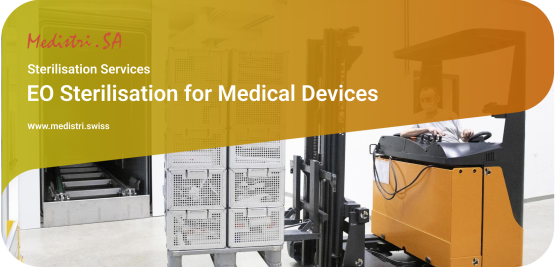(Download: EO Sterilisation for Medical Devices in PDF by Medistri)
From the patient gown in a doctor’s office to the surgical kit in open heart surgery, everything used on, in, or by patients and doctors must be sterile. That’s critical to preventing dangerous infection.
For many medical devices, sterilization with EO may be the only method that effectively sterilizes and does not damage the device during the sterilization process. Medical devices made from certain polymers (plastic or resin), metals, or glass, or that have multiple layers of packaging or hard-to-reach places (for example, catheters) are likely to be sterilized with EO. EO sterilization is an important sterilization method that manufacturers widely use to keep medical devices safe.
EO Sterilisation is a process that uses gas to kill microorganisms on medical devices, pharmaceutical products, and other products. The process involves exposing the product to EO gas in a sealed chamber, where the gas penetrates the product and kills any microorganisms present. EO Sterilisation is effective against a wide range of microorganisms, including bacteria, viruses, and fungi.
Sterilisation is an important method that manufacturers widely use to keep medical devices safe for patient use. It is a considered a ‘cold’ sterilization technique and offers high compatibility with most materials used in the manufacturing & packaging of medical devices, such as plastics, polymers, metals and glass. For many medical devices, EO sterilisation may be the only method that effectively sterilizes without damaging the device during the sterilisation process.
👉 The sterilisation process is carefully monitored and controlled to ensure that the product is not damaged or compromised during the process. The equipment used for the EO Sterilisation is designed to maintain precise conditions of temperature, humidity, and gas concentration to ensure that the process is effective and safe.
1. Preconditioning: The product to be sterilized is placed in a sealed chamber and exposed to a controlled humidity and temperature to prepare it for the sterilisation process.
2. Sterilisation: The EO gas is introduced into the chamber, and the product is exposed to the gas for a specific period of time. The gas penetrates the product and kills any microorganisms present.
3. Aeration: After the sterilisation process is complete, the chamber is vented to remove the EO gas. The product is then aerated for a specific period of time to remove any residual gas and reduce the levels of EO to safe levels. At Medistri, samples of the items are tested for Endotoxin/LAL, Residuals & Sterility in our in-house laboratory to confirm that the sterilization process was effective.
4. Laboratory Testing: The product is then tested to ensure that it has been effectively sterilised and that the levels of EO are within safe limits.
Ethylene oxide has been used for sterilization since the 1940s. One of the primary reasons for EO’s popularity is its ability to penetrate plastic packaging and sterilize the devices inside.
The international standard that details the development and validation of a process for sterilizing medical devices using ethylene oxide is ISO 11135. This standard specifies requirements for the development, validation and routine control of an ethylene oxide sterilization process for medical devices in both the industrial and health care facility settings. It was last reviewed and confirmed in 2020.
👉 ISO 11135 provides guidance on how to validate the sterilization process. Once the process as a whole has been validated, the medical device manufacturer, regulatory bodies, and end users can be confident that the final product is sterile.
EO Sterilisation is a widely used method for sterilising medical devices that cannot be sterilised by other sterilisation technologies or for industrial quantities. It offers several advantages, including compatibility with various materials, high efficacy, low-temperature sterilisation, and large-scale sterilisation.
However, proper safety measures must be taken during the sterilisation process to ensure the safety of workers and patients. Medical device manufacturers must also ensure that the residual EO levels in the device are within safe limits before releasing them to the market. residual EO levels in the device are within safe limits before releasing them to the market.
Medistri SA is equipped with 5 EO Sterilisation chambers each with capacities up to 16 palettes. Our chambers have been engineered to allow you to sterilise loads up to 200cm of height, allowing you to maximise the size of your final production loads, and reduce costs. Medistri can currently sterilise about 73'000 palettes annually using its EO sterilisation infrastructure. And we're always working towards making this number larger.
🎯 To learn more about Medistri’s EO Sterilisation, visit on our website at www.medistri.swiss or directly contact our team at contact@medistri.swiss.
- The Medistri Team
#Medistri
